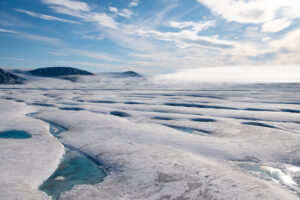
Environment
Last bastion of ice
What the collapse of the Milne ice shelf and the loss of a rare Arctic ecosystem might teach us about a changing planet
- 2894 words
- 12 minutes
This article is over 5 years old and may contain outdated information.
Science & Tech

There’s no such thing as bad weather, just bad clothing. This truism has been passed from parent to child during many a Canadian winter, but amid the shuffle of mittens and downy parkas, proper footwear sometimes gets lost in the mix. This can be a dangerous oversight, considering that icy conditions send more than 21,000 people to the emergency room each year in Ontario alone. Now, a team of researchers hopes to help people stay safe and upright.
Most of the winter boots sold in Canada won’t protect people from tumbling on tricky surfaces, according to a study conducted in the WinterLab at the Toronto Rehabilitation Institute–University Health Network. The researcher team put 98 boot models (spanning both safety work boot and casual boot styles) through a slip test on ice, and only nine kept the study participants standing.
“You’d think winter boots would be adapted for winter, but they’re not. Some of the boots are so bad that they couldn’t stand up on level ice,” Geoff Fernie, research director at the rehabilitation institute, told the CBC.
Excluding car accidents, falling on ice causes more serious injuries throughout the winter than anything else, and leads to more hospital admissions than all winter sports and recreational activities combined.
In a tiltable five-metre by five-metre room, with a floor made entirely of ice and artificial wind that can reach 30 kilometres per hour, scientists had participants walk back and forth on an increasingly steep incline (while harnessed to the ceiling so that if/when they slipped they suffered no bodily damage).
The top-rated boots only earned a single snowflake out of three, meaning they’d held fast while traversing a seven-degree incline. To earn the coveted three-snowflake rating, a boot would have to grip on a 15-degree incline. Although boot tread proved helpful, the scientists found that the material on the sole was the most important factor.
The two materials that stuck better than the rest were the gritty rubbers called Green Diamond and Arctic Grip, the latter of which was awarded Best in Show at the 2016 Outdoor Retailer Winter Market.
The tested boots that use these compounds and earned a single snowflake are
Get the full list of rankings on the Rate My Treads website.
Are you passionate about Canadian geography?
You can support Canadian Geographic in 3 ways:

Environment
What the collapse of the Milne ice shelf and the loss of a rare Arctic ecosystem might teach us about a changing planet

Science & Tech
The Canadian High Arctic Research Station is set to open in Cambridge Bay, Nunavut, later this year. How will it affect our understanding and appreciation of the North and the rapid change occurring there?

People & Culture
For generations, hunting, and the deep connection to the land it creates, has been a mainstay of Inuit culture. As the coastline changes rapidly—reshaping the marine landscape and jeopardizing the hunt—Inuit youth are charting ways to preserve the hunt, and their identity.

Exploration
She's also combining her knowledge and skills to uncover the secrets of climate change